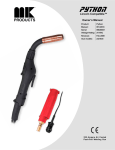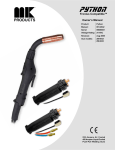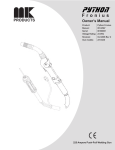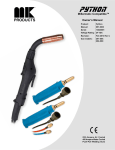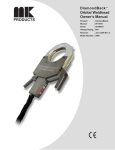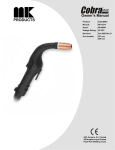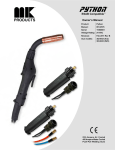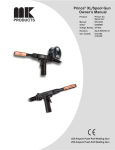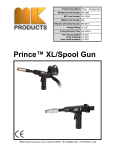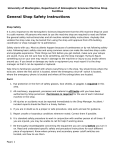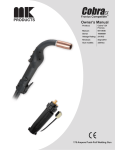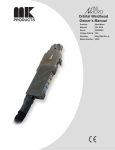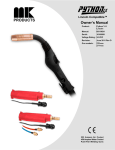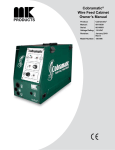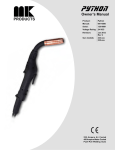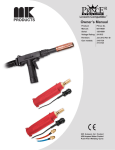Download Owner`s Manual Liquid Cooled Fronius with Euro
Transcript
Liquid Cooled Fronius with Euro Connector Owner’s Manual Product: Python Manual: 091-0586 Serial: 09020001 Voltage Rating: 24 VDC Revision: Feb 2009 Rev B Gun Models: 233-8xx With Quick Connect Coolant Hose Fittings 400 Ampere Push-Pull Welding Gun Table of Contents Safety Considerations.........................................................................i-iii Installation................................................................................ Section A Technical Specifications......................................................................................1 Support Equipment Required..............................................................................1 Gun Lead Connections.......................................................................................1 Coolant Recommendations.................................................................................1 Operation..................................................................................Section B General...............................................................................................................2 Controls and Settings..........................................................................................2 Trigger Adjustment..............................................................................................2 Drive Roll and Idler Rolls....................................................................................2 Accessories..............................................................................Section C Insulated Drive Roll Kits......................................................................................3 Replacement Kits................................................................................................4 Snake Skins........................................................................................................4 Contact Tips........................................................................................................4 Barrels.................................................................................................................4 Maintenance.............................................................................Section D Periodic Maintenance.........................................................................................5 Recommended Spare Parts List.........................................................................6 Troubleshooting........................................................................Section E Troubleshooting Guide........................................................................................6 Testing The Gun..................................................................................................6 Appendices...............................................................................Section F Diagrams / Parts List...........................................................................................9 Mechanical........................................................................................................10 Electrical...........................................................................................................17 Warranty Declaration of Conformity for European Community (CE) Products Note This information is provided for units with CE certification (see rating label on unit). MK MillerProducts, Electric Mfg.Inc. Co. Manufacturer’s Name: 1635 W.Armstrong Spencer Street 16882 Ave. Appleton, WI 54914 USA Irvine, CA 92606 Manufacturer’s Address: Declares that the product: ® XR-Control Python conforms to the following Directives and Standards: Directives Low Voltage Directive: 73/23/EEC Electromagnetic Compatibility (EMC) Directive: 89/336/EEC Machinery Directives: 89/392/EEC, 91/368/EEC, 93/C 133/04, 93/68/EEC Standards Arc Welding Equipment Part I: Welding Power Sources: IEC 60974-1 (September 1998 – Second Edition) Arc Welding Equipment: Wirefeed Systems: IEC 974-5 (September 1997 – Draft Revision) Degrees of Protection Provided By Enclosures (IP Code): IEC 529:1989 (November 1989 - First Edition) Insulation Coordination For Equipment With Low-Voltage Systems: Part I: Principles, Requirements and Tests: IEC 664-1: 1992 (October 1992 – First Edition) Electromagnetic Compatibility, (EMC): EN 50199 (August 1995) Torches And Guns For Arc Welding, EN 50078 Safety Considerations ELECTRIC ARC WELDING EQUIPMENT CAUTION : READ BEFORE ATTEMPTING INSTALLATION, OPERATION OR MAINTENANCE OF THIS EQUIPMENT 1-1 INTRODUCTION This equipment is intended for ultimate application by commercial/industrial users and for operation by persons trained and experienced in the use and maintenance of welding equipment. Operation should not be undertaken without adequate training in the use of such equipment. Training is available from many public and private schools or similar facilities. Safe practices in the installation, operation and maintenance of this equipment requires proper training in the art, a careful study of the information provided with the equipment, and the use of common sense. Rules for safe use are generally provided by suppliers of welding power sources, compressed gas suppliers, and electrode suppliers. Careful compliance with these rules will promote safe use of this equipment. The following Safety Rules cover some of the more generally found situations. READ THEM CAREFULLY. In case of any doubt, obtain qualified help before proceeding. 1-2 GENERAL PRECAUTIONS A. Burn Prevention ELECTRIC ARC WELDING PRODUCES H I G H I N T E N S I T Y H E AT A N D ULTRAVIOLET RADIANT ENERGY WHICH MAY CAUSE SERIOUS AND PERMANENT EYE DAMAGE AND WHICH MAY DAMAGE ANY EXPOSED SKIN AREAS. Wear helmet with safety goggles or glasses with side shields underneath, appropriate filter lenses or plates (protected by clear cover glass). This is a must for welding or cutting (and chipping) to protect the eyes from radiant energy and flying metal. Replace cover glass when broken, pitted, or spattered. Medical first aid and eye treatment. First aid facilities and a qualified first aid person should be available for each shift unless medical facilities are close by for immediate treatment of flash burns of the eyes and skin burns. Wear protective clothing - leather (or asbestos) gauntlet gloves, hat, and high safety-toe shoes. Button shirt collar and pocket flaps, and wear cuffless trousers to avoid entry of sparks and slag. Avoid oily or greasy clothing. A spark may ignite them. Flammable hair preparations should not be used by persons intending to weld or cut. Hot metal such as electrode stubs and work pieces should never be handled without gloves. misuse of compressed gases and cylinders, and short circuits. Ear plugs should be worn when working on overhead or in a confined space. A hard hat should be worn when others work overhead. BE AWARE THAT flying sparks or falling slag can pass through cracks, along pipes, through windows or doors, and through wall or floor openings, out of sight of the goggled operator. Sparks can fly many feet. B. Toxic Fume Prevention WARNING: The use of this product may result in exposure to chemicals known to the State of California to cause cancer and birth defects or other reproductive harm. Adequate ventilation. Severe discomfort, illness or death can result from fumes, vapors, heat, or oxygen enrichment or depletion that welding (or cutting) may produce. Prevent them with adequate ventilation. NEVER ventilate with oxygen. Lead-, cadmium-, zinc-, mercury-, berylliumbearing and similar materials, when welded or cut, may produce harmful concentrations of toxic fumes. Adequate local exhaust ventilation must be used, or each person in the area, as well as the operator, must wear an air-supplied respirator. For beryllium, both must be used. Metals coated with or containing materials that emit toxic fumes should not be heated unless coating is removed form the work surface, the area is well ventilated, or the operator wears an air-supplied respirator. Work in a confined space only while it is being ventilated and, if necessary, while wearing an air-supplied respirator. Gas leaks in a confined space should be avoided. Leaked gas in large quantities can change oxygen concentration dangerously. Do not bring gas cylinders into a confined space. Leaving confined space, shut OFF gas supply at source to prevent possible accumulation of gases in the space if downstream valves have been accidentally opened or left open. Check to be sure that the space is safe before reentering it. Vapors from chlorinated solvents can be decomposed by the heat of the arc (or flame) to form PHOSGENE, a highly toxic gas, and other lung and eye irritating products. The ultraviolet (radiant) energy of the arc can also decompose trichloroethylene and perchloroethylene vapors to form phosgene. DO NOT WELD or cut where solvent vapors can be drawn into the welding or cutting atmosphere or where the radiant energy can penetrate to atmospheres containing even minute amounts of trichloroethylene or perchloroethylene. C. Fire and Explosion Prevention Causes of fire and explosion are: combustibles reached by the arc, flame, flying sparks, hot slag, or heated material, To prevent fires and explosion: Keep equipment clean and operable, free of oil, grease, and (in electrical parts) of metallic particles that can cause short circuits. If combustibles are in area, do NOT weld or cut. Move the work if practicable, to an area free of combustibles. Avoid paint spray rooms, dip tanks, storage areas, ventilators. If the work cannot be moved, move combustibles at least 35 feet away, out of reach of sparks and heat; or protect against ignition with suitable and snugfitting, fire-resistant covers or shields. Walls touching combustibles on opposite sides should not be welded on (or cut). Walls, ceilings, and floor near work should be protected by heat-resistant covers or shields. Fire watcher must be standing by with suitable fire extinguishing equipment during and for some time after welding or cutting if: 1. Appreciable combustibles (including building construction) are within 35 feet. 2. Appreciable combustibles are further than 35 feet, but can be ignited by sparks. 3. Openings (concealed or visible) in floors or walls within 35 feet may expose combustibles to sparks. 4. Combustibles adjacent to walls, ceilings, roofs, or metal partitions can be ignited by radiant or conducted heat. Hot work permit should be obtained before operation to ensure supervisor’s approval that adequate precautions have been taken. After work is done, check that area is free of sparks, glowing embers, and flames. An empty container that held combustibles, or that can produce flammable or toxic vapors when heated, must never be welded on or cut, unless container has first been cleaned in accordance with industry standards. This includes: a thorough steam or caustic cleaning (or a solvent of water washing, depending on the combustible’s solubility), followed by purging and inerting with nitrogen or carbon dioxide, Python® Liquid Cooled Fronius with Euro Connector Owner's Manual - Page i and using protective equipment. Water-filling just below working level may substitute for inerting. caps securely; mark MT; keep them separate from FULLS, and return promptly. A container with unknown contents should be cleaned (see paragraph above). Do NOT depend on sense of smell or sight to determine if it is safe to weld or cut. Prohibited use. Never use a cylinder or its contents for other than its intended use, NEVER as a support or roller. Locate or secure cylinders so they cannot be knocked over. Hollow castings or containers must be vented before welding or cutting. They can explode. Passageways and work areas. Keep cylinders clear of areas where they may be stuck. Explosive atmospheres. NEVER weld or cut where the air may contain flammable dust, gas, or liquid vapors (such as gasoline). Transporting cylinders. With a crane, use a secure support such as a platform or cradle. Do NOT lift cylinders off the ground by their valves or caps, or by chains, slings, or magnets. D. Compressed Gas Equipment The safe handling of compressed gas equipment is detailed in numerous industry publications. The following general rules cover many of the most common situations. 1. Pressure Regulators Regulator relief valve is designed to protect only the regulator from overpressure; it is not intended to protect any downstream equipment. Provide such protection with one or more relief devices. Never connect a regulator to a cylinder containing gas other than that for which the regulator was designed. Remove faulty regulator from service immediately for repair (first close cylinder valve). The following symptoms indicate a faulty regulator: Leaks - if gas leaks externally. Excessive Creep - if delivery pressure continues to rise with downstream valve closed. Faulty Gauge - if gauge pointer does not move off stop pin when pressurized, nor returns to stop pin after pressure release. Repair. Do NOT attempt repair. Send faulty regulators for repair to manufacturer ’s designated repair center, where special techniques and tools are used by trained personnel. 2. Cylinders Cylinders must be handled carefully to prevent leaks and damage to their walls, valves, or safety devices: Do NOT expose cylinders to excessive heat, sparks, slag, and flame, etc. that may cause rupture. Do not allow contents to exceed 55 degrees C (130 degrees F.) Cool with water spray where such exposure exists. Protect cylinders, particularly valves from bumps, falls, falling objects, and weather. Replace caps securely when moving cylinders. Stuck valve. Do NOT use a hammer or wrench to open a cylinder valve that cannot be opened by hand. Notify your supplier. Mixing gases. NEVER try to mix any gases in a cylinder. NEVER refill any cylinder. Cylinder fittings should never be modified or exchanged. 3. Hose Prohibited use. Never use hose other than that designed for the specified gas. A general hose identification rule is: red for fuel gas, green for oxygen, and black for inert gases. Use ferrules or clamps designed for the hose (not ordinary wire or other substitute) as a binding to connect hoses to fittings. No copper tubing splices. Use only standard brass fittings to splice hose. Avoid long runs to prevent kinks and abuse. Suspend hose off ground to keep it from being run over, stepped on, or otherwise damaged. Coil excess hose to prevent kinks and tangles. Avoid electrical circuit contact with cylinders including third rails, electrical wires, or welding circuits. They can produced short circuit arcs that may lead to a serious accident. (See 1-3C) Protect hose from damage by sharp edges, and by sparks, slag, and open flame. ICC or DOT marking must be on each cylinder. It is an assurance of safety when the cylinder is properly handled. Repair leaky or worn hose by cutting area out and splicing. Do NOT use tape. Identifying gas content. Use only cylinders with name of gas marked on them; do not rely on color to identify gas content. Notify supplier if unmarked. NEVER DEFACE or alter name, number, or other markings on a cylinder. It is illegal and hazardous. Empties: Keep valves closed, replace Examine hose regularly for leaks, wear, and loose connections. Immerse pressured hose in water; bubbles indicate leaks 4. Proper Connections Clean cylinder valve outlet of impurities that may clog orifices and damage seats before connecting regulator. Except for hydrogen, crack valve momentarily, pointing outlet away from people and sources of ignition. Wipe with a clean, lintless cloth. Match regulator to cylinder. Before connecting, check that the regulator label and cylinder marking agree, and that the regulator inlet and cylinder outlet match. NEVER Connect a regulator designed for a particular gas or gases to a cylinder containing any other gas. Tighten connections. When assembling threaded connections, clean and smooth seats where necessary. Tighten. If connection leaks, disassemble, clean, and retighten, using properly fitting wrench. Adapters. Use a CGA adapter (available from your supplier) between cylinder and regulator, if one is required. Use two wrenches to tighten adapter marked RIGHT and LEFT HAND threads. Regulator outlet (or hose) connections may be identified by right hand threads for oxygen and left hand threads (with grooved hex on nut or shank) for fuel gas. 5. Pressurizing Steps: Drain regulator of residual gas through suitable vent before opening cylinder (or manifold valve) by turning adjusting screw in (clockwise). Draining prevents excessive compression heat at high pressure seat by allowing seat to open on pressurization. Leave adjusting screw engaged slightly on single-stage regulators. Stand to side of regulator while opening cylinder valve. Open cylinder valve slowly so that regulator pressure increases slowly. When gauge is pressurized (gauge reaches regulator maximum) leave cylinder valve in following position: for oxygen and inert gases, open fully to seal stem against possible leak; for fuel gas, open to less than one turn to permit quick emergency shut-off. Use pressure charts (available from your supplier) for safe and efficient recommended pressure settings on regulators. Check for leaks on first pressurization and regularly thereafter. Brush with soap solution. Bubbles indicate leaks. Clean off soapy water after test; dried soap is combustible. E. User Responsibilities Follow all Safety Rules. Remove leaky or defective equipment from service immediately for repair. Read and fol low user manual instructions. F. Leaving Equipment Unattended Close gas supply at source and drain gas. G. Rope Staging-Support Rope staging-support should not be used for welding or cutting operation; rope may burn. 1-3 ARC WELDING Comply with precautions in 1-1, 12, and this section. Arc Welding, properly done, is a safe process, but a careless operator invites trouble. Python® Liquid Cooled Fronius with Euro Connector Owner's Manual - Page ii The equipment carries high currents at significant voltages. The arc is very bright and hot. Sparks fly, fumes rise, ultraviolet and infrared energy radiates, weldments are hot, and compressed gases may be used. The wise operator avoids unnecessary risks and protects himself and others from accidents. A. Burn Protection Comply with precautions in 1-2. The welding arc is intense and visibly bright. Its radiation can damage eyes, penetrate lightweight clothing, reflect from light-colored surfaces, and burn the skin and eyes. Skin burns resemble acute sunburn; those from gas-shielded arcs are more severe and painful. DON’T GET BURNED; COMPLY WITH PRECAUTIONS. 1. Protective Clothing Wear long-sleeve clothing in addition to gloves, hat, and shoes. As necessary, use additional protective clothing such as leather jacket or sleeves, flameproof apron, and fire-resistant leggings. Avoid outer garments of untreated cotton. Bare skin protection. Wear dark, substantial clothing. Button collar to protect chest and neck, and button pockets to prevent entry of sparks. 2. Eye and Head Protection Protect eyes from exposure to arc. Eyes may be damaged by radiant energy when exposed to the electric arc, even when not looking in the direction of the arc. Never look at an electric arc without protection. Welding helmet or shield containing a filter plate shade no. 12 or denser must be used when welding. Place over face before striking arc. Protect filter plate with a clear cover plate. Cracked or broken helmet or shield should NOT be worn; radiation can be passed through to cause burns. Cracked, broken, or loose filter plates must be replaced IMMEDIATELY. Replace clear cover plate when broken, pitted, or spattered. Flash goggles with side shields MUST be worn under the helmet to give some protection to the eyes should the helmet not be lowered over the face before an arc is struck. Looking at an arc momentarily with unprotected eyes (particularly a high intensity gasshielded arc) can cause a retinal burn that may leave a permanent dark area in the field of vision. 3. Protection of Nearby Personnel Enclose the welding area. For production welding, a separate room or enclosed bay is best. In open areas, surround the operation with low-reflective, noncombustible screens or panels. Allow for free air circulation, particularly at floor level. Viewing the weld. Provide face shields for all persons who will be looking directly at the weld. Others working in area. See that all persons are wearing flash goggles. Before starting to weld, make sure that screen flaps or bay doors are closed. B. Toxic Fume Prevention Comply with precautions in 1-2B. Generator engine exhaust must be vented to the outside air. Carbon monoxide can kill. C. Fire and Explosion Prevention Comply with precautions in 1-2C. Equipment’s rated capacity. Do not overload arc welding equipment. It may overheat cables and cause a fire. Loose cable connections may overheat or flash and cause afire. Never strike an arc on a cylinder or other pressure vessel. It creates a brittle area that can cause a violent rupture or lead to such a rupture later under rough handling. D. Compressed Gas Equipment Comply with precautions in 1-2D. E. Shock Prevention Exposed electrically hot conductors or other bare metal in the welding circuit, or in ungrounded, electrically-HOT equipment can fatally shock a person whose body becomes a conductor. DO NOT STAND, SIT, LIE, LEAN ON, OR TOUCH a wet surface when welding without suitable protection. To protect against shock: Keep body and clothing dry. Never work in damp area without adequate insulation against electrical shock. Stay on a dry duckboard, or rubber mat when dampness or sweat cannot be avoided. Sweat, sea water, or moisture between body and an electrically HOT part - or grounded metal - reduces the body surface electrical resistance, enabling dangerous and possibly lethal currents to flow through the body. 1. Grounding the Equipment When installing, connect the frames of each unit such as welding power source, control, work table, and water circulator to the building ground. Conductors must be adequate to carry ground currents safely. Equipment made electrically HOT by stray currents may shock, possibly fatally. Do NOT GROUND to electrical conduit, or to a pipe carrying ANY gas or a flammable liquid such as oil or fuel. Three-phase connection. Check phase requirement of equipment before installing. If only three-phase power is available, connect single-phase equipment to only two wires of the three-phase line. Do NOT connect the equipment ground lead to the third (live) wire, or the equipment will become electrically HOT - a dangerous condition that can shock, possibly fatally. If a line cord with a ground lead is provided with the equipment for connection to a switch box, connect the ground lead to the grounded switch box. If a three-prong plug is added for connection to a grounded mating receptacle, the ground lead must be connected to the ground prong only. If the line cord comes with a three-prong plug, connect to a grounded mating receptacle. Never remove the ground prong from a plug, or use a plug with a broken ground prong. 2. Connectors Fully insulated lock-type connectors should be used to join welding cable lengths. 3. Cables Frequently inspect cables for wear, cracks, and damage. IMMEDIATELY REPLACE those with excessively worn or damaged insulation to avoid possibly lethal shock from bared cable. Cables with damaged areas may be taped to give resistance equivalent to original cable. Keep cable dry, free of oil and grease, and protected from hot metal and sparks. 4. Terminals and Other Exposed Parts Terminals and other exposed parts of electrical units should have insulating covers secured before operation. 5. Electrode Wire Electrode wire becomes electrically HOT when the power switch of gas metal-arc welding equipment is ON and welding gun trigger is pressed. Keep hands and body clear of wire and other HOT parts. 6. Safety Devices Safety devices such as interlocks and circuit breakers should not be disconnected or shunted out. Before installation, inspection, or service of equipment, shut OFF all power, and remove line fuses (or lock or red-tag switches) to prevent accidental turning ON of power. Disconnect all cables from welding power source, and pull all 115 volts line-cord plugs. Do not open power circuit or change polarity while welding. If, in an emergency, it must be disconnected, guard against shock burns or flash from switch arcing. Leaving equipment unattended. Always shut OFF, and disconnect all power to equipment. Power disconnect switch must be available near the welding power source. Before welding, check ground for continuity. Be sure conductors are touching bare metal of equipment frames at connections. Python® Liquid Cooled Fronius with Euro Connector Owner's Manual - Page iii Thank You For selecting a quality product. We want you to take pride in operating this product...as much pride as we have in bringing the product to you! Please Examine Carton and Equipment For Damage Immediately When this equipment is shipped, title passes to the purchaser upon receipt by the carrier. Consequently, claims for material damaged in shipment must be made by the purchaser against the transportation company at the time the shipment is received. Please record your equipment identification information below for future reference. This information can be found on your machine nameplate. Model Name & Number _____________________ Code & Serial Number _____________________ Date of Purchase _____________________ Whenever you request replacements parts for, or information on this equipment always supply the information you have recorded above. Read this Owner’s Manual completely before attempting to use this equipment. Save this manual and keep it handy for quick reference. Pay particular attention to the safety instructions we have provided for your protection. Python® Liquid Cooled Fronius with Euro Connector Owner's Manual - Page iv Section A Installation Technical Specifications Wire Capacity Aluminum Cored............................................ .030" - 1/16" (0.8 mm - 1.6 mm) Solid and Hard Wire...................................... .030" - .045" (0.8 mm - 1.2 mm) Wire Speed (At rated feeder input voltage)..................... 800 ipm (20.3 mpm) Duty Cycle - 60% (All ratings are using Argon gas).........................400 Amps Support Equipment Required • C.V. or C.C. power source of sufficient capacity for your needs. • Regulated gas supply and hoses. • Properly sized power leads from power source to wire feeder and ground. Gun Lead Connections Power Cable Python® liquid cooled guns utilize a specially designed cable with a #6 AWG cable inside a 5/16" (13 mm) diameter hose. Liquid coolant is used with this cable and the #10 liquid cooled gas cup, the system is rated at 400 amps @ 60% duty cycle. The welding power connection is incorporated through the central body connector. The power cable ends are threaded fittings which screw into the gun body and the central body connector. These connections utilize a conductive sealant and are tightened to a specific torque setting (reference lead assembly drawing in the Appendix for details). Conduit The Python® comes standard with a poly-lined conduit, for feeding aluminum wire. The longer fitting with a shallow groove is used on the gun end. A set screw located on top of the gun handle secures the conduit in place. The cabinet end of the conduit is incorporated into the central body connector. The conduit liner extends from the central body adapter fitting and is designed to slide into the TPS-2700 wire drive up to the trailing drive rolls. Gas Hose The gas hose is pushed over a barbed fitting on the gun body and secured with a plastic tie wrap. The cabinet end of the gas hose is incorporated into the central body connector. Coolant Connections The blue coolant (supply) hose is pushed over a barbed fitting on the gun body and secured with a plastic tie wrap. The red coolant (return) hose connects through the central body connector. Both hose fittings are male quick connect fittings. Control Cable A multi-conductor control cable is used on the Python®. The gun end of the cable is secured with a cable clamp and the wires are connected to the potentiometer, micro switch, motor and the gun body mechanically. Slack is left in the electric cable as it exits the back of the gun to prevent cable and/or wire breakage. The cabinet end of the control cable uses a 9-Pin, rectangular connector. Python® Liquid Cooled Fronius with Euro Connector Owner's Manual - Page 1 Coolant Recommendations Use Cobra Coolant (Aluminum Protection), P/N 931-0060. Cobra Coolant does not contain reactive sulphur or chlorine and does not react with copper, brass or aluminum. The coolant flow rate should be a minimum of 15 GPH (1 qt/min) between 35 and 45psi. Contact the re-circulator manufacturer for specifications on pressure. Section B Operation General The Python® maintains a constant, steady, uniform wire feed speed, regardless of curved or looped wire conduit. The constant push exerted by the slave motor in the cabinet, combined with the pull of the gun motor, causes the wire to literally float friction-free through the wire conduit. The 24VDC gun motor is controlled by a three and three-quarter (3 3/4) turn potentiometer in the gun handle. Controls and Settings Potentiometer The laterally-positioned potentiometer is located in the lower end of the handle, providing up to 800 ipm (20.3 mpm) with 3 3/4 turns. Micro Switch The micro switch assembly consists of a normally open micro switch and solder-attached leads. Trigger Sensitivity The amount of trigger lever travel can be shortened for a quicker or more responsive action. A more sensitive trigger lever is produced by reducing the gap between the trigger lever and the micro switch lever. By turning-in the trigger sensitivity adjustment screw, it closed the gap between the trigger lever and the micro switch lever. This will enable the operator to increase the sensitivity of the trigger lever. Sensitivity Adjustment With the wire feeder turned on (with or without welding wire loaded), turn the screw in until the micro-switch is activated. Once activated, the gun and wire feeder motors will begin feeding wire. Retract the screw accordingly until the system is deactivated and adjusted to the operators' satisfaction. Drive Roll and Idler Rolls The Python® comes standard with a knurled drive roll and a grooved idler roll, which will handle both steel and aluminum wire with diameters from .0301/16 inch. Optional insulated V-groove drive rolls are also available for aluminum wire if desired (see optional kits). Drive roll tension is accomplished with a unique spring-loaded pressure screw. The Python® comes from the factory with the pressure adjustment screw preset. NO ADJUSTMENT required for ANY WIRE SIZE OR ALLOY Python® Liquid Cooled Fronius with Euro Connector Owner's Manual - Page 2 Drive Roll Installation/Removal Note: Neither of the handles needs to be removed to access the drive or idler rolls. 1. Pull the cam lever away from the idler roll. This will relieve the pressure against the drive roll (as shown in Figure 1). Cam Lever 2. Align the drive roll removal tool over the flats of the drive roll (as shown in Figure 2). Hold the gun with one hand or on a table top, with the other hand give the removal tool a quick snap-turn in the CLOCKWISE DIRECTION. Figure 1 3. Once the drive roll is loose, continue to spin drive roll in the clockwise direction to remove the drive roll from the gun. 4. Install a new drive roll on the left-hand threaded shaft. The drive roll will selftighten when it is feeding wire. Idler Roll Installation and Removal (Reference Figure 3) Figure 2 1. Using a slot type screwdriver, loosen idler screw, taking care not to lose lock washer under idler roll. 2. Insert new idler roll and lock washer onto screw, insuring that idler groove is toward top and lock washer is beneath. 3. Tighten screw until tight. NOTE: Lock washer must be under idler roll or it will not turn freely. Figure 3 Section C Options and Accessories Insulated Drive Roll Kits Used to prevent preheating of the wire which may soften it and clog the liner. This picking up of current at the drive rolls rather than at the contact tip is usually not a problem unless using too large of a contact tip or excessively oxidized aluminum wire. Insulated Groove Drive Roll Kit.......................................................005-0640 For .030" (0.8 mm) dia. aluminum wire. Includes insulated drive roll and idler roll assy. Insulated Groove Drive Roll Kit.......................................................005-0716 For .035" (0.9 mm) dia. aluminum wire. Includes insulated drive roll and idler roll assy. Insulated Groove Drive Roll Kit.......................................................005-0642 For .040" (1.0 mm) dia. aluminum wire. Includes insulated drive roll and idler roll assy. Python® Liquid Cooled Fronius with Euro Connector Owner's Manual - Page 3 Insulated Groove Drive Roll Kit.......................................................005-0718 For 3/64" (1.2 mm) dia. aluminum wire. Includes insulated drive roll and idler roll assy. Insulated Groove Drive Roll Kit....................................................... 005-0644 For .062" (1.6 mm) dia. aluminum wire. Includes insulated drive roll and idler roll assy. Replacement Kits Handle Kit Gun.................................................................................. 005-0699 Left and right handles, screws and drive roll door, as a replacement for all Python® guns. Trigger Kit.......................................................................................... 005-0694 Trigger adjustment kit includes a spring and sensitivity adjustment screw replacement for all Python® guns. Micro Switch Kit................................................................................ 005-0701 Replacement micro switch assembly for all Python® guns. Potentiometer Kit.............................................................................. 005-0695 Replacement potentiometer assembly for all Python® guns. Barrel Insulator Kit........................................................................... 005-0696 Replacement barrel insulator and taper lock nut. Conduits Flat spiral steel conduit for steel & cored wire. 15 ft./4.5m...................................................................................... 615-0621-15 25 ft./7.6m...................................................................................... 615-0621-25 35 ft/10.7m..................................................................................... 615-0621-35 50 ft./15.2m.................................................................................... 615-0621-50 Snake Skins A Snake Skin protective cover is standard on the Python®. See below for replacement part numbers. 15 ft./4.5m........................................................................................... 931-0110 25 ft./7.6m........................................................................................... 931-0122 35 ft/10.7m.......................................................................................... 931-0132 50 ft./15.2m.........................................................................................931-0123 Contact Tips Wire Size Heavy Duty Contact Tip - 3/8" Diameter* Tip ID .030” (0.8mm) .040” (1.0mm) .035” (0.9mm) Arc Tip Length .045” (1.1mm) Spray Short Spray 1.57” (39.9mm) 1.82” (46.2mm) 1.57” (39.9mm) .047” (1.2mm) .054” (1.37mm) Short Spray 1.82” (46.2mm) 1.57” (39.9mm) .060” (1.5mm) Short Spray 1.82” (46.2mm) 1.57” (39.9mm) .074” (1.9mm) .085” (2.16mm) Spray Spray 1.57” (39.9mm) 1/16” (1.6mm) *Use of tip removal tool is recommended **standard - furnished with gun sold in a quantity of 250 †† sold in a quantity of 500 † Python® Liquid Cooled Fronius with Euro Connector Owner's Manual - Page 4 Part No. 621-0390-25 621-0396-25 621-0391-25 621-0391-250† 621-0391-500†† 621-0397-25 621-0392-25 621-0392-250† 621-0392-500†† 621-0398-25 621-0393-25** 621-0393-250† 621-0393-500†† 621-0394-25 621-0395-25 Gun Barrel Liners Part Number Description 931-0137 Teflon liner package, 5 pieces 615-0338 Steel wire only, .030 - .1/16" (0.8 - 0.9mm) Barrel Assemblies 450 Amps, Water Cooled (P/N 003-2317) Standard on WC 300 Amps, Water Cooled (P/N 003-2380) Optional on WC The Python® comes standard with a 60˚ curved barrel. The barrel assembly locks to the Python® body using the patented EZ Lock™ system. Optional Barrels - Liquid Cooled 6" Straight........................................................................................... 003-2315 6" Curved, 45°.................................................................................... 003-2316 12" Straight ........................................................................................ 003-2318 12" Curved, 45° ................................................................................. 003-2319 18" Straight ........................................................................................ 003-2320 18" Curved, 45°.................................................................................. 003-2321 Optional 300 Amp Water Cooled Barrel Assemblies Straight, Water Cooled Barrel Assembly, 300 Amps........................... 003-2380 Curved, 45° Water Cooled Barrel Assembly, 300 Amps..................... 003-2381 Curved, 60° Water cooled Barrel Assembly, 300 Amps...................... 003-2382 Barrel Removal and Installation CAUTION: Power-off the coolant pump before removing or loosening liquid-cooled cups and barrels. To remove the barrel assembly, loosen the patented EZ Lock™ taper lock nut until it is clear of the threads. Pull barrel out of the gun body. To replace a barrel assembly, push the barrel assembly into the gun body until it clicks to a stop. To assure proper seating of the barrel, open the drive/ idler roll door in the top of the handle. The rear face of the barrel should now be flush with the gun body. Take care not to damage the o-rings when inserting into the body. Tighten taper lock nut assembly firmly so that barrel cannot rotate while welding. Barrel Rotation To rotate a barrel assembly, loosen the patented EZ Lock™ taper lock nut assembly no more than 1 turn. Rotate barrel to the position of your choice and re-tighten taper lock nut assembly firmly so that the barrel cannot rotate. CAUTION: Do not attempt to weld without the barrel being tightly secured in the gun body, or damage to the barrel or body may result. Python® Liquid Cooled Fronius with Euro Connector Owner's Manual - Page 5 Section D Maintenance Periodic Maintenance Your Python® is designed to provide years of reliable service. Maintenance of the gun will normally consist of a general cleaning of the wire guide system, including barrels, drive rolls, and conduits at regular intervals. Remove spatter build-up from inside of nozzles with a hardwood stick. The only parts that are subject to normal wear are the conduit, contact tips, nozzles, barrel liners, wire guides, drive and idler rolls. A supply of these parts should be maintained on hand. The number of units in operation and the importance of minimal down time will determine to what extent spare parts should be stocked on hand. See the recommended spare parts list for the most commonly replaced parts. It is recommended that you blow out your conduit each time you install a new spool of wire. If repairs do become necessary, qualified shop maintenance personnel can easily replace any part. Reference the table below for suggested Maintenance Tools used with the Python® welding gun. Maintenance Tools Tool Part Number Drive Roll Removal Tool 931-0100 Tip Removal Tool 931-0002 Recommended Spare Parts Listed in the table below is the factory recommendation of the necessary spare parts which should be kept on hand for maintaining proper operation of the Python® welding gun. This list, in no way, indicates that these parts are more likely to fail or cause equipment damage. This is not an indication of premature failure or defect in manufacture of said parts. Recommended Spare Parts List Qty. Part Number Description 1 615-0620-15 15' Conduit 1 615-0620-25 25' Conduit 1 615-0620-35 35' Conduit 1 615-0620-50 50' Conduit 2 005-0694 Trigger Assy Kit 2 005-0695 Potentiometer Assy Kit 1 005-0699 Handle Kit 2 005-0701 Micro-Switch Assy Kit 10 511-0101 Drive Roll 5 005-0686 Idler Roll Kit 2 931-0137 Liner Package - 5 pieces each Python® Liquid Cooled Fronius with Euro Connector Owner's Manual - Page 6 Section E Troubleshooting Guide To aid in troubleshooting problems with your welding equipment, it is best to understand the basic theory of operation for this Push-Pull System. The slave motor in the feeder runs at a fast, constant speed, but has very low torque. It is always trying to feed more wire than the gun motor wants, and when the motor gets all it wants, it slows the slave motor, preventing a bird’s nest. Because of the low torque produced by the slave motor, a brake system is used to prevent wire overrun rather than tension. The drag adjustment in the feeder is used simply to keep the wire slightly taut, so it will not pull off the spool while feeding wire. The high torque 24VDC gun motor is controlled by an electric speed control located in the feeder, and a pot located in the gun. The gun motor, potentiometer, and micro switch are connected to the cabinet/control box via a control cable and Amphenol connector. If this cable becomes damaged, a variety of symptoms can occur, depending on which wire(s) break. To test, check each wire for continuity and shorts. Remember, the micro switch in the gun activates both the slave motor and gun motor circuits in the cabinet. Therefore, if the slave motor and brake solenoid operate, but the gun does not, look more toward the gun motor’s 24VDC circuits, speed control, control cable, or the gun motor. If nothing operates, look more toward the slave motor’s input, micro switch leads, or micro switch. Testing The Gun Reference the 9-pin rectangular diagram on the Python® electrical diagram for information about pin-outs and locations. Motor Check Remove the connector from the cabinet. Using the 9-pin connector, check the resistance across pins “1” and “6” (motor leads). The resistance across the motor should be between 5 - 10 ohms as the potentiometer is turned. If an open circuit or short exist, check the motor leads and motor independently. Testing the Gun Potentiometer Using the 9-pin connector, check the resistance across pin “3” (wiper) and pin “2”. The resistance should vary from 0 - 5K ohms as the potentiometer is turned. Check the resistance across pin “3” (wiper) and pin “7”. The resistance should vary from 5K - 0 ohms as the potentiometer is turned. Testing the Micro Switch Using the 9-pin connector, check for continuity across pins “9” and “5” when the trigger is pressed. Python® Liquid Cooled Fronius with Euro Connector Owner's Manual - Page 7 Troubleshooting Table Symptoms No wire feed at gun, feeder not operating, i.e. no slave motor or brake solenoid. No wire feed at gun, feeder operating properly. Wire feeds, but welding wire is not energized. Wire feeds erratically. Wire feeds one speed only. Wire walks out of drive rolls. Cause Circuit breaker in feeder/ control box open. Remedy Reset. Micro-switch defective/not Replace switch. Check being activated. switch for operation. Broken electrical cable. Check micro-switch wires for continuity. Circuit breaker in feeder/ control box open. Check motor leads for short. Reset. Bad potentiometer. Check potentiometer with meter. Broken electrical cable. Check motor and potentiometer wires for continuity. Loose or no cable connections. Check all power connections. Welding power source. Check power source. Dirty or worn conduit. Blow out or replace conduit. Wrong size contact tip. See contact tip table. Idler roll stuck. Check for lock washer under idler roll, or replace if damaged. Bad potentiometer. Check with meter. Broken electrical cable. Check potentiometer wires for continuity or short. Bad speed control. See specific feeder/ control owner's manual for speed control operation. Idler roll upside-down. Place groove in idler roll toward top. Rear wire guide missing. Replace wire guide. Consult wire feeder and welding power supply owners manuals for further problem solving solutions. Python® Liquid Cooled Fronius with Euro Connector Owner's Manual - Page 8 Section F Appendices Python® Diagrams / Parts List Head Assembly Exploded Parts View........................................ 10 Head Assembly Parts List.......................................................... 11 Front Body Assembly Parts View............................................... 12 Rear Body Assembly Parts View............................................... 13 Barrel Assembly Parts View....................................................... 14 Cup Insulator and O-Ring Maintenance.................................... 15 Lead Assembly Parts View........................................................ 16 Electrical/Connector Pinout....................................................... 17 Python® Liquid Cooled Fronius with Euro Connector Owner's Manual - Page 9 Apply compound Noalox to contact surfaces for installation. Python® Head Assembly P/N 003-2286 Python® Liquid Cooled Fronius with Euro Connector Owner's Manual - Page 10 Python® Liquid Cooled Fronius with Euro Connector Owner's Manual - Page 11 Qty. 1 1 1 1 1 1 1 1 1 1 2 1 2 No. 1 2 3 4 5 6 7 8 9 10 11 12 13 320-0084 319-0258 319-0254 211-0077 003-2287 005-0695 003-2209 003-2153 005-0701 003-2125 003-2108 005-0694 002-0629 Part No. Scr Button 4-40 x 3/16 ST Scr FH Phil 82 4-40 5/8 SST Scr FH Phil 82 4-40 x 3/8 SST Motor 24VDC Assy Rear Body W/C Python Assy Speed Control Pot Kit Guide Wire Assy Assy Boot Torch Micro Swx Kit Assy Knob Pot Assy Front Body W/C Python Trigger Kit Assy Cam Idler Arm Description 26 25 24 23 22 21 20 19 18 17 16 15 14 No. 0.30 ft. 1 1 1 1 1 1 1 1 1 4 9 Qty. 737-0048 437-0268 437-0253 005-0699 435-1585 431-1637 431-1622 421-0018 405-0706 338-0153 333-0005 328-0012 Part No. Python Fronius Head Assembly Tube Insulation 9 AWG, Clear Cover Knob Python Door Molded Python Handle Kit: Includes line items 14,19, and 24 Strap Motor Python Screw Hex 3/8-20 x 3/8 Scr Shoulder 1/8 x 4-40 Pin Dowel 3/32 x 7/8 Label Scr SHC 1-72 x 3/8 Wshr Spr LK #6 Scr SHC 6-32 x 3/8 Description Python® Front Body Assembly P/N 003-2108 Items 3, 4 & 9 available as package kit: P/N 005-0686 Python® Front Body Assembly No. Qty. Part No. Description 1 - - 2 - - 3* 1 325-0206 10-24 x 3/8 PH Screw 4* 1 333-0082 # 10 Lock Washer 5 1 419-0092 0.29 x 0.047 x 0.32 Comp. Spring 6 1 421-0525 1/8 x 7/8 SST Dowel Pin 7 1 431-1663 Idler Adjusting Screw 8 1 431-1598 Idler Arm 9* 1 511-0001 Idler Wire Feed Assembly 10 1 511-0101 Drive roll Not available separately * Items 3, 4 & 9 available as package kit: Part number 005-0686 Python® Liquid Cooled Fronius with Euro Connector Owner's Manual - Page 12 Python® Rear Body Assembly P/N 003-2287 APPLY SILICONE LUBRICANT FOR INSTALLATION Python® Rear Body Assembly No. Qty. Part No. Description 1 - - Not available separately 2 6 303-0096 O-Ring .145 ID x .07 W 3 1 321-1104 Set Screw Mod Conduit 4 1 336-0020 Scr PH Phil 4-40 x 5/16 SST 5 1 411-0243 Tie Wrap SCR #4 Python® Liquid Cooled Fronius with Euro Connector Owner's Manual - Page 13 Python® Barrel Assembly P/N 003-2317 *Apply silicone lubricant to items 5, and 6 before installing. Python® Liquid Cooled 60º Barrel Assembly No. Qty. Part No. 1 - - Not available separately Description 2 1 003-2213 Assy Taper Lock Barrel 3 1 261-0141 Insulator Barrel 4 1 261-0381 Insulator Cup with five O-Rings 5* 8 303-0010 O-Ring .489 ID x .07 W 6* 2 303-0094 O-Ring .301 ID x .07 W 7 1 313-0091 Retaining Ring 0.625 Shaft 8 1 431-0977 Retaining Nut 9 1 431-1774 Cup Insulator Barrel 10 0.70 ft. 615-0178 Liner Tef 0.084 ID x 0.174 OD 11 1 621-0065 Cup #10 Assy 12 1 621-0393 Tip HD Spray .060 Python® Liquid Cooled Fronius with Euro Connector Owner's Manual - Page 14 CUP INSULATOR AND O-RING MAINTENANCE CAUTION: Power-off the coolant pump before disassembling liquid-cooled barrels. 1. Unscrew Retaining Nut and slide back on barrel. 2. Using a firm pull and twist action, the Liquid-Cooled Gas Cup can be removed from the Cup Insulator. 3. Inspect the Cup Insulator and o-rings (included with Insulator) for wear and proper lubrication. It is considered good practice to replace all o-rings at the same time. 4. To remove the Cup Insulator, it must be unscrewed and pulled from the barrel. Use a rag or towel (due to o-ring lubrication) and wrap it around the Cup Insulator. Unscrew and pull when completly unthreaded from barrel. Be sure the Insulator is fully unscrewed from the threads. Pulling the Insulator over barrel threads will damage the threads on the Insulator. Inspect o-rings on barrel for wear and lubrication. It is considered good practice to replace all o-rings at the same time. 5. To install the Cup Insulator, it must be pushed all the way onto the barrel then screwed onto the threads. If necessary, place small amount of o-ring lubricant on the inside diameter of the Cup Insulator, this will help it slide onto the barrel. Push the Insulator onto the barrel until it bottoms out, screw onto barrel threads. The Insulator MUST be all the way onto the barrel to assure proper coolant passage and from blocking the gas outlet orifices. 6. Push Liquid-Cooled Gas Cup onto Cup Insulator. Slide Retaining Nut forward and tighten. Insulator Barrel Gas Outlet Orifices Correct Installation Incorrect Installation Python® Liquid Cooled Fronius with Euro Connector Owner's Manual - Page 15 Python® Lead Assembly P/N 003-2310 Series APPLY HOSE LUBRICATION INSIDE HOSE BEFORE INSTALLATION SECURE HOSE WITH TIE WRAP APPLY HOSE LUBRICATION INSIDE HOSE BEFORE INSTALLATION SECURE HOSE WITH TIE WRAP APPLY COMPOUND NOALOX TO THREAD FOR INSTALLATION S *Items 3 and 5 not shown for clarity Python® Lead Assembly No Qty Description 15' Part No. 25' Part No. 35' Part No. 50' Part No. 1 1 Handle Adaptor Support 003-2285 2 1 Assy Central Body Adaptor W/C 003-2288 3* 2 Wrap Spiral Cord 261-0094 4 1 Set Screw Cup 10-32 x 1/4 ST 321-0071 5* 4 Tie Wrap 411-0045 6 1 Conduit Liner Fitting 431-1788 7 1 Nut Handle Adaptor 437-0265 8 1 Assy Hose Liquid Red, Quick Conn. 552-0211 9 1 Assy Hose Liquid Blue, Quick Conn. 552-0238-15 552-0238-25 552-0238-35 552-0238-50 10 1 Assy Gas Hose 552-0241-15 552-0241-25 552-0241-35 552-0241-50 11 1 Assy Teflon Tube Conduit 615-0620-15 615-0620-25 615-0620-35 615-0620-50 12 1 Power Cable WC #6 843-0680-15 843-0680-25 843-0680-35 843-0680-50 13 1 Assy Controller Cable 843-0655 843-0656 843-0658 843-0657 14 1 Snake Skin 931-0110 931-0122 931-0132 931-0123 Python® Liquid Cooled Fronius with Euro Connector Owner's Manual - Page 16 Python® Electrical Schematic/ Connector Pinout Python® Liquid Cooled Fronius with Euro Connector Owner's Manual - Page 17 LIMITED WARRANTY Effective August 1, 2008 This warranty supersedes all previous MK Products warranties and is exclusive, with no other guarantees or warranties expressed or implied. LIMITED WARRANTY - MK Products Inc., Irvine, California warrants that all new and unused equipment furnished by MK Products is free from defects in workmanship and material as of the time and place of delivery by MK Products. No warranty is made by MK Products with respect to trade accessories or other items manufactured by others. Such trade accessories and other items are sold subject to the warranties of their respective manufacturers, if any. MK Products’ warranty does not apply to components having normal useful life of less than one (1) year, such as relay points, wire conduit, tungsten, and welding gun parts that come in contact with the welding wire, including gas cups, gas cup insulators, and contact tips where failure does not result from defect in workmanship or material. MK Products shall, exclusively remedy the limited warranty or any duties with respect to the quality of goods, based upon the following options: (1) repair (2) replacement (3) where authorized in writing by MK Products, the reasonable cost of repair or replacement at our Irvine, California plant. As a matter of general policy only, MK Products may honor an original user’s warranty claims on warranted equipment in the event of failure resulting from a defect within the following periods from the date of delivery of equipment to the original user: 1. Power Supplies and Wire Feed Cabinets ..................3 years 2. Weldheads, CobraCooler, Positioners, Prince XL and Prince XL Spool Guns, Python, CobraMAX, Cobra SX, Cobra MX ....................................................................1 year 3. Sidewinder Spool Gun, Prince SG Spool Guns, Modules ...... ............................................................................... 180 days 4. Repairs/Exchanges/Parts ...................................... 90 days Classification of any item into the foregoing categories shall be at the sole discretion of MK Products. Notification of any failure must be made in writing within 30 days of such failure. A copy of the invoice showing the date of sale must accompany products returned for warranty repair or replacement. All equipment returned to MK Products for service must be properly packaged to guard against damage from shipping. MK Products will not be responsible for any damages resulting from shipping. Normal surface transportation charges (one way) for products returned for warranty repair or replacement will be borne by MK Products, except for products sold to foreign markets. ANY EXPRESS WARRANTY NOT PROVIDED HEREIN AND ANY IMPLIED WARRANTY, GUARANTY, OR REPRESENTATION AS TO PERFORMANCE, AND ANY REMEDY FOR BREACH OF CONTRACT WHICH, BUT FOR THIS PROVISION, MIGHT ARISE BY IMPLICATION, OPERATION OF LAW, CUSTOM OF TRADE, OR COURSE OF DEALING, INCLUDING ANY IMPLIED WARRANTY OF MERCHANTABILITY OR OF FITNESS FOR PARTICULAR PURPOSE, WITH RESPECT TO ANY AND ALL EQUIPMENT FURNISHED BY MK PRODUCTS, IS EXCLUDED AND DISCLAIMED BY MK PRODUCTS. EXCEPT AS EXPRESSLY PROVIDED BY MK PRODUCTS IN WRITING, MK’s PRODUCTS ARE INTENDED FOR ULTIMATE PURCHASE BY COMMERCIAL/INDUSTRIAL USERS AND FOR OPERATION BY PERSONS TRAINED AND EXPERIENCED IN THE USE AND MAINTENANCE OF WELDING EQUIPMENT AND NOT FOR CONSUMERS OR CONSUMER USE. MK PRODUCTS’ WARRANTIES DO NOT EXTEND TO, AND NO RE-SELLER IS AUTHORIZED TO EXTEND MK PRODUCTS’ WARRANTIES TO ANY CONSUMER. USE OF OTHER THAN GENUINE MK PRODUCTS’ CONSUMABLES, PARTS, AND ACCESSORIES MAY INVALIDATE YOUR PRODUCT WARRANTY. 16882 Armstrong Ave. ® Warranty on theIrvine, Python Welding Gun is recognized and administered by the original equipment CA 92606 manufacturer, known as MK Products, Inc. Tel (949) 863-1234 Fax (949) 474-1428 www.mkproducts.com 16882 Armstrong Ave. Irvine, CA 92606 Tel (949)863-1234 Fax (949)474-1428 www.mkproducts.com August 1, 2008 This page intentionally blank 16882 Armstrong Ave. Irvine, CA 92606 Tel (949)863-1234 Fax (949)474-1428 www.mkproducts.com




























